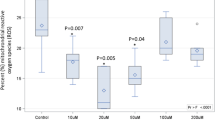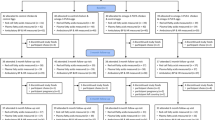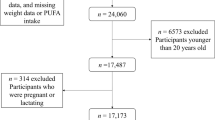Abstract
Objectives: To assess the effects of providing a wide range of foodstuffs containing n-3 polyunsaturated fatty acids (PUFA), occurring naturally or from fortification, on intake and blood and tissue proportions of n-3 PUFA.
Design: Before/after dietary intervention study.
Setting: Adelaide, Australia.
Subjects: 16 healthy males recruited from the community.
Interventions: Subjects were provided with a range of foodstuffs naturally containing n-3 PUFA (fresh fish, canned fish, flaxseed meal, canola oil) and items fortified with fish oil (margarine spread, milk, sausages, luncheon meat, french onion dip). Food choices were left to the discretion of each subject. Intake was estimated by diet diary. Blood was collected at—2, 0, 2, and 4 weeks for fatty acid analysis.
Main outcome measures: Dietary intakes; plasma, platelet, and mononuclear cell phospholipid fatty acids.
Results: Consumption of n-3 PUFA increased significantly: α-linolenic acid (ALA) from 1.4 to 4.1 g/day (P<0.001), eicosapentaenoic acid (EPA) from 0.03 to 0.51 g/day (P<0.001), and docosahexaenoic acid (DHA) from 0.09 to 1.01 g/day (P<0.001). Linoleic acid (LA) intake decreased from 13.1 to 9.2 g/day (P<0.001). The proportions of EPA and DHA increased significantly in all phospholipid pools examined; plasma EPA from 1.13% of total fatty acids to 3.38% (P<0.001) and DHA from 3.76 to 7.23% (P<0.001); mononuclear cell EPA from 0.40 to 1.25% (P<0.001) and DHA from 2.33 to 4.08% (P<0.001); platelet EPA from 0.41 to 1.2% (P<0.001) and DHA from 1.64 to 3.07% (P<0.001).
Conclusions: Incorporating fish oil into a range of novel commercial foods provides the opportunity for wider public consumption of n-3 PUFA with their associated health benefits.
Sponsorship: Dawes Scholarship, Royal Adelaide Hospital.
This is a preview of subscription content, access via your institution
Access options
Subscribe to this journal
Receive 12 print issues and online access
$259.00 per year
only $21.58 per issue
Buy this article
- Purchase on Springer Link
- Instant access to full article PDF
Prices may be subject to local taxes which are calculated during checkout
Similar content being viewed by others
References
Ascherio A, Rimm EB, Giovannucci EL, Spiegelman D, Stampfer M & Willett WC (1996): Dietary fat and risk of coronary heart disease in men: cohort follow up study in the United States. BMJ 313, 84–90.
Cleland LG & James MJ (2000): Fish oil and rheumatoid arthritis: antiinflammatory and collateral health benefits. J. Rheumatol. 27, 2305–2307.
Cleland LG, James MJ, Neumann MA, D'Angelo M & Gibson RA (1992): Linoleate inhibits EPA incorporation from dietary fish-oil supplements in human subjects. Am. J. Clin. Nutr. 55, 395–399.
Cunnane SC, Hamadeh MJ, Liede AC, Thompson LU, Wolever TM & Jenkins DJ (1995): Nutritional attributes of traditional flaxseed in healthy young adults. Am. J. Clin. Nutr. 61, 62–68.
Das UN (2000): Beneficial effect(s) of n-3 fatty acids in cardiovascular diseases: but, why and how? Prostaglandins Leukot. Essent. Fatty Acids 63, 351–362.
de Deckere EA, Korver O, Verschuren PM & Katan MB (1998): Health aspects of fish and n-3 polyunsaturated fatty acids from plant and marine origin. Eur. J. Clin. Nutr. 52, 749–753.
de Lorgeril M, Renaud S, Mamelle N, Salen P, Martin JL, Monjaud I, Guidollet J, Touboul P and Delaye J (1994): Mediterranean alpha-linolenic acid-rich diet in secondary prevention of coronary heart disease. Lancet 343, 1454–1459.
Dolecek TA & Granditis G (1991): Dietary polyunsaturated fatty acids and mortality in the Multiple Risk Factor Intervention Trial (MRFIT). World Rev. Nutr. Diet. 66, 205–216.
Emken EA, Adlof RO & Gulley RM (1994): Dietary linoleic acid influences desaturation and acylation of deuterium-labeled linoleic and linolenic acids in young adult males. Biochim. Biophys. Acta 1213, 277–288.
Gerster H (1998): Can adults adequately convert alpha-linolenic acid (18/3n-3) to eicosapentaenoic acid (20/5n-3) and docosahexaenoic acid (22/6n-3). Int. J. Vitam. Nutr. Res. 68, 159–173.
Hu FB, Manson JE & Willett WC (2001): Types of dietary fat and risk of coronary heart disease: a critical review. J. Am. Coll. Nutr. 20, 5–19.
Hu FB, Stampfer MJ, Manson JAE, Rimm EB, Wolk A, Colditz CA, Hannekens CH and Willett WC (1999): Dietary intake of alpha-linolenic acid and risk of fatal ischemic heart disease among women. Am. J. Clin. Nutr. 69, 890–897.
Kris-Etherton P, Harris WS & Appel LJ (2002): AHA Scientific Statement: Fish consumption, fish oil, omega-3 fatty acids, and cardiovascular disease. Circulation 106, 2747–2757.
Lovegrove JA, Brooks CN, Murphy MC, Gould BJ & Williams CM (1997): Use of manufactured foods enriched with fish oils as a means of increasing long-chain n-3 polyunsaturated fatty acid intake. Br. J. Nutr. 78, 223–236.
Mantzioris E, Cleland LG, Gibson RA, Neumann MA, Demasi M & James MJ (2000): Biochemical effects of a diet containing foods enriched with n-3 fatty acids. Am. J. Clin. Nutr. 72, 42–48.
Mantzioris E, James MJ, Gibson RA & Cleland LG (1994): Dietary substitution with an alpha-linolenic acid-rich vegetable oil increases eicosapentaenoic acid concentrations in tissues. Am. J. Clin. Nutr. 59, 1304–1309.
Naylor RL, Goldburg RJ, Primavera JH, Kautsky N, Beveridge MCM, Clay J, Foke C, Lubchenco J, Mooney H and Troell M, (2000): Effect of aquaculture on world fish supplies. Nature 405, 1017–1024.
Saldeen T, Wallin R & Marklinder I (1998): Effects of a small dose of stable fish oil substituted for margarine in bread on plasma phospholipid fatty acids and serum triglycerides. Nutr. Res. 18, 1483–1492.
Scientific Review Committee (1990): Nutrition Recommendations. Ottawa: Minister of National Health and Welfare, Canada.
Simopoulos AP, Leaf A & Salem N (2000): Workshop Statement on the Essentiality of and Recommended Dietary Intakes for Omega-6 and Omega-3 Fatty Acids. Prostaglandins Leukot. Essent. Fatty Acids 63, 119–121.
Singh RB, Niaz MA, Sharma JP, Kumar R, Rastogi V & Moshiri M (1997): Randomized, double-blind, placebo-controlled trial of fish oil and mustard oil in patients with suspected acute myocardial infarction: the Indian experiment of infarct survival–4. Cardiovasc. Drugs Ther. 11, 485–491.
The British Nutrition Foundation (1992): Unsaturated Fatty Acids—Nutritional and Physiological Significance: The Report of the British Nutrition Foundation's Taskforce. London: Chapman & Hall.
Visioli F, Rise P, Plasmati E, Pazzucconi F, Sirtori CR & Galli C (2000): Very low intakes of N-3 fatty acids incorporated into bovine milk reduce plasma triacylglycerol and increase HDL-cholesterol concentrations in healthy subjects. Pharmacol. Res. 41, 571–576.
Wallace JMW, McCabe AJ, Robson PJ, Keogh MK, Murray CA, Kelly PM, Marquez-Ruiz G, McGlynn H, Gilmora WS and Strain JJ (2000): Bioavailability of n-3 polyunsaturated fatty acids (PUFA) in foods enriched with microencapsulated fish oil. Ann. Nutr. Metab. 44, 157–162.
Acknowledgements
We acknowledge Meadow Lea Foods Ltd (Sydney, Australia) for supplying the margarine spread, canola oil, salad dressing, and mayonnaise, Pauls Ltd (Brisbane, Australia) for supplying the milk, Safcol Ltd (Adelaide, Australia) for supplying the canned salmon and sardines, Conroys Smallgoods Pty Ltd (Adelaide, Australia) for supplying the luncheon meat, Enreco Inc (Manitowoc, WI, USA) for supplying the flax products and Roche Vitamins (Sydney, Australia) for supplying the fish oil. This study was supported in part by the National Heart Foundation of Australia.
Author information
Authors and Affiliations
Corresponding author
Rights and permissions
About this article
Cite this article
Metcalf, R., James, M., Mantzioris, E. et al. A practical approach to increasing intakes of n-3 polyunsaturated fatty acids: use of novel foods enriched with n-3 fats. Eur J Clin Nutr 57, 1605–1612 (2003). https://doi.org/10.1038/sj.ejcn.1601731
Received:
Revised:
Accepted:
Published:
Issue Date:
DOI: https://doi.org/10.1038/sj.ejcn.1601731



